Economics Assignment: Australia's Economic Dynamics and Interest Rates
VerifiedAdded on 2021/09/30
|12
|2128
|101
Report
AI Summary
This economics assignment analyzes the economic dynamics of Australia, focusing on key indicators such as GDP growth, employment rates, and inflation. The report examines the Reserve Bank of Australia's monetary policies, particularly the interest rate, and forecasts its trajectory over the next six to twelve months. It explores the reasons behind these dynamics, including increasing consumption and investment expenditures, and the demand for the domestic currency. Furthermore, the report assesses the potential impacts of these interest rate changes on a specific business, considering both the benefits of cheaper imports and the increased burden of variable interest rate loans. The conclusion summarizes the key findings, emphasizing the mixed implications of the forecasted interest rate changes on the business's budget, influenced by the interplay of currency value fluctuations and loan interest costs.
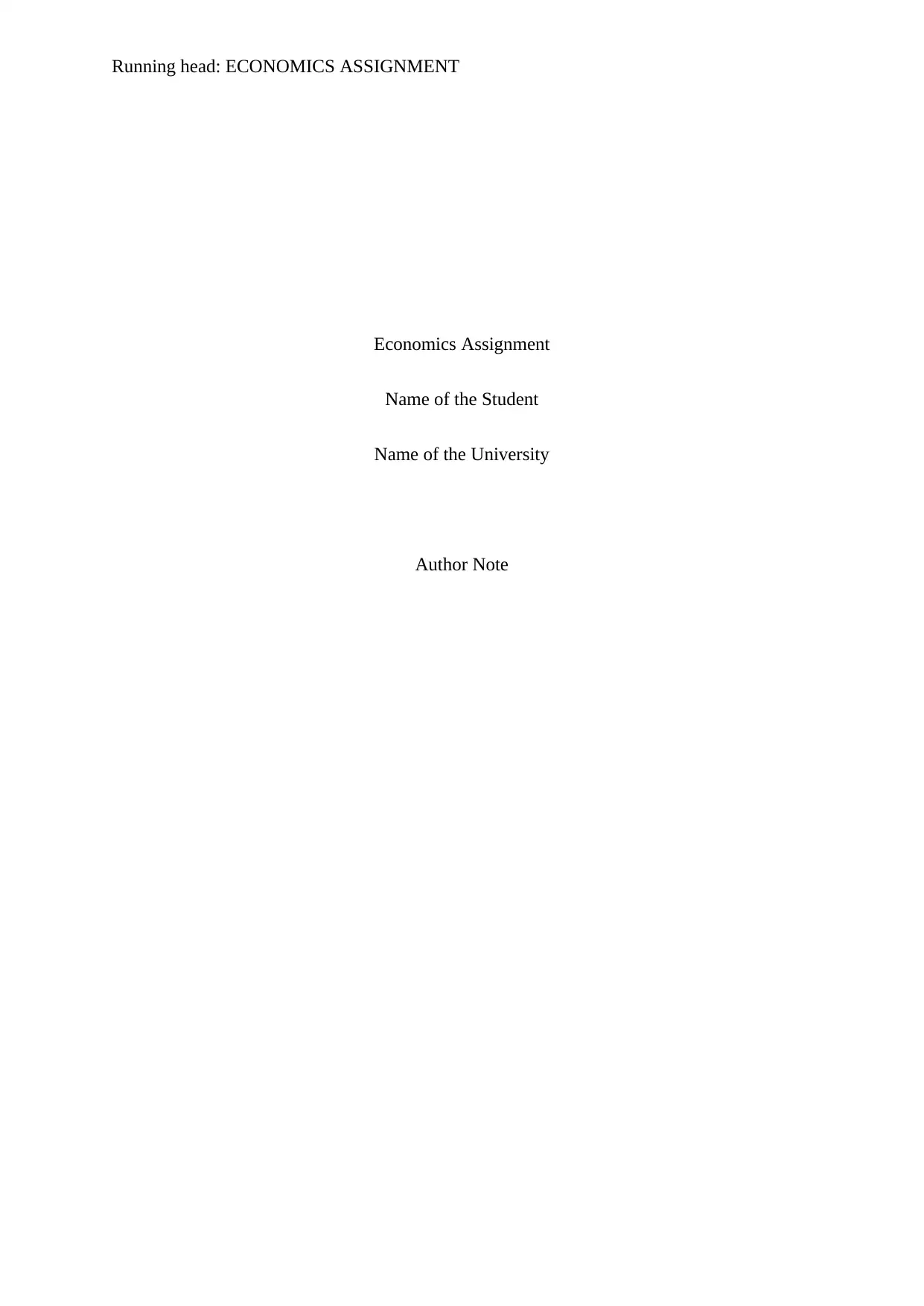
Running head: ECONOMICS ASSIGNMENT
Economics Assignment
Name of the Student
Name of the University
Author Note
Economics Assignment
Name of the Student
Name of the University
Author Note
Paraphrase This Document
Need a fresh take? Get an instant paraphrase of this document with our AI Paraphraser
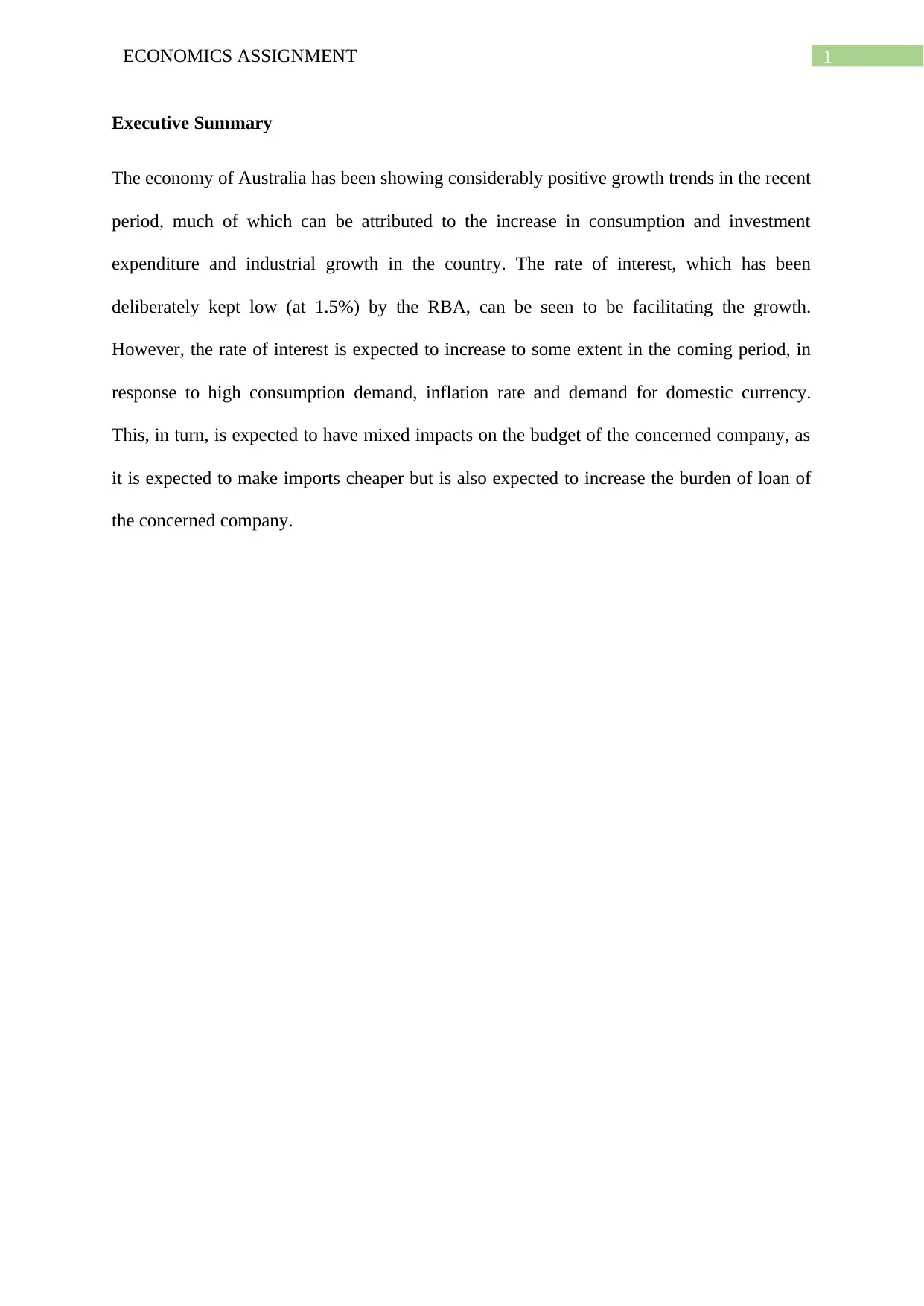
1ECONOMICS ASSIGNMENT
Executive Summary
The economy of Australia has been showing considerably positive growth trends in the recent
period, much of which can be attributed to the increase in consumption and investment
expenditure and industrial growth in the country. The rate of interest, which has been
deliberately kept low (at 1.5%) by the RBA, can be seen to be facilitating the growth.
However, the rate of interest is expected to increase to some extent in the coming period, in
response to high consumption demand, inflation rate and demand for domestic currency.
This, in turn, is expected to have mixed impacts on the budget of the concerned company, as
it is expected to make imports cheaper but is also expected to increase the burden of loan of
the concerned company.
Executive Summary
The economy of Australia has been showing considerably positive growth trends in the recent
period, much of which can be attributed to the increase in consumption and investment
expenditure and industrial growth in the country. The rate of interest, which has been
deliberately kept low (at 1.5%) by the RBA, can be seen to be facilitating the growth.
However, the rate of interest is expected to increase to some extent in the coming period, in
response to high consumption demand, inflation rate and demand for domestic currency.
This, in turn, is expected to have mixed impacts on the budget of the concerned company, as
it is expected to make imports cheaper but is also expected to increase the burden of loan of
the concerned company.
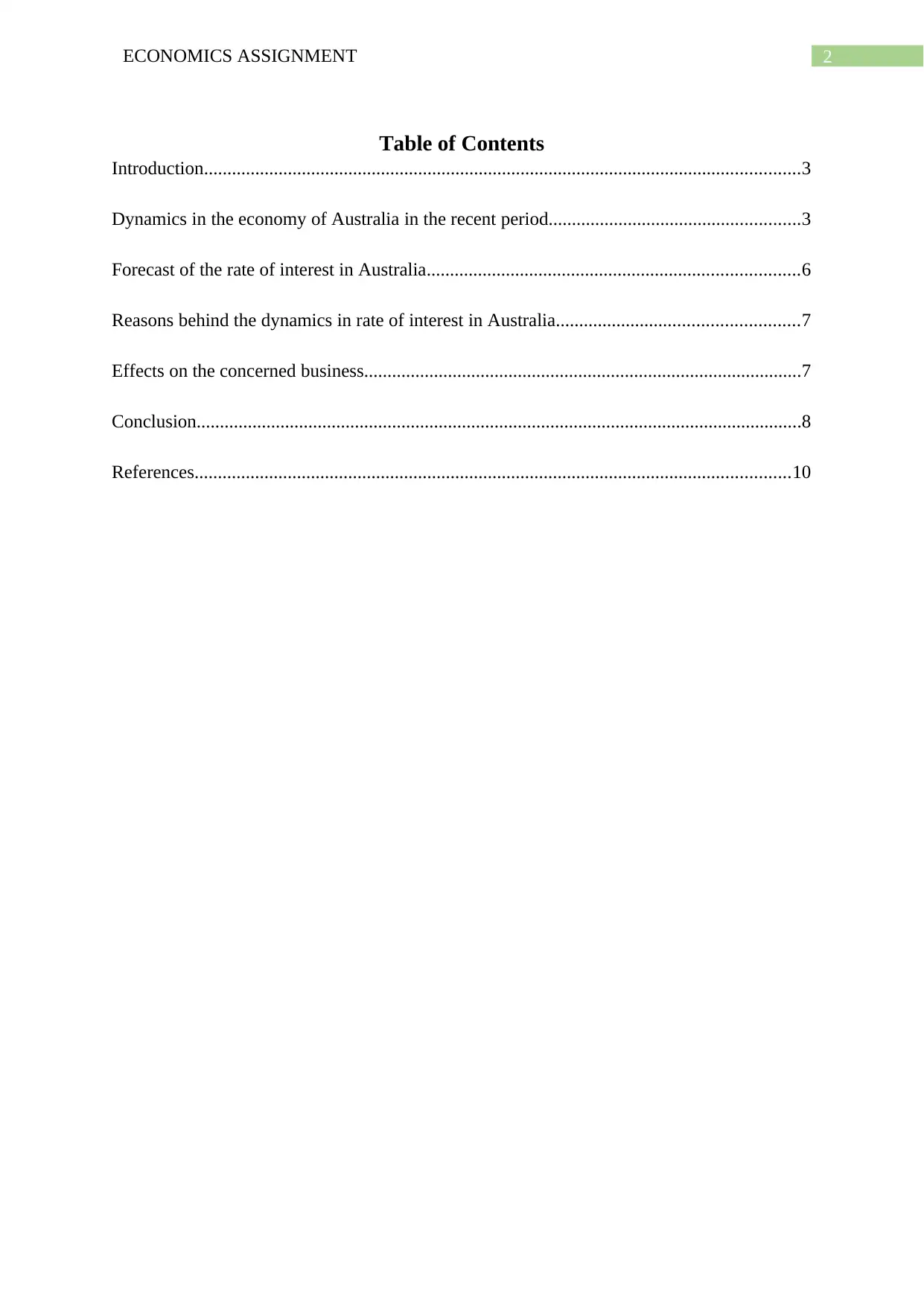
2ECONOMICS ASSIGNMENT
Table of Contents
Introduction................................................................................................................................3
Dynamics in the economy of Australia in the recent period......................................................3
Forecast of the rate of interest in Australia................................................................................6
Reasons behind the dynamics in rate of interest in Australia....................................................7
Effects on the concerned business..............................................................................................7
Conclusion..................................................................................................................................8
References................................................................................................................................10
Table of Contents
Introduction................................................................................................................................3
Dynamics in the economy of Australia in the recent period......................................................3
Forecast of the rate of interest in Australia................................................................................6
Reasons behind the dynamics in rate of interest in Australia....................................................7
Effects on the concerned business..............................................................................................7
Conclusion..................................................................................................................................8
References................................................................................................................................10
⊘ This is a preview!⊘
Do you want full access?
Subscribe today to unlock all pages.

Trusted by 1+ million students worldwide
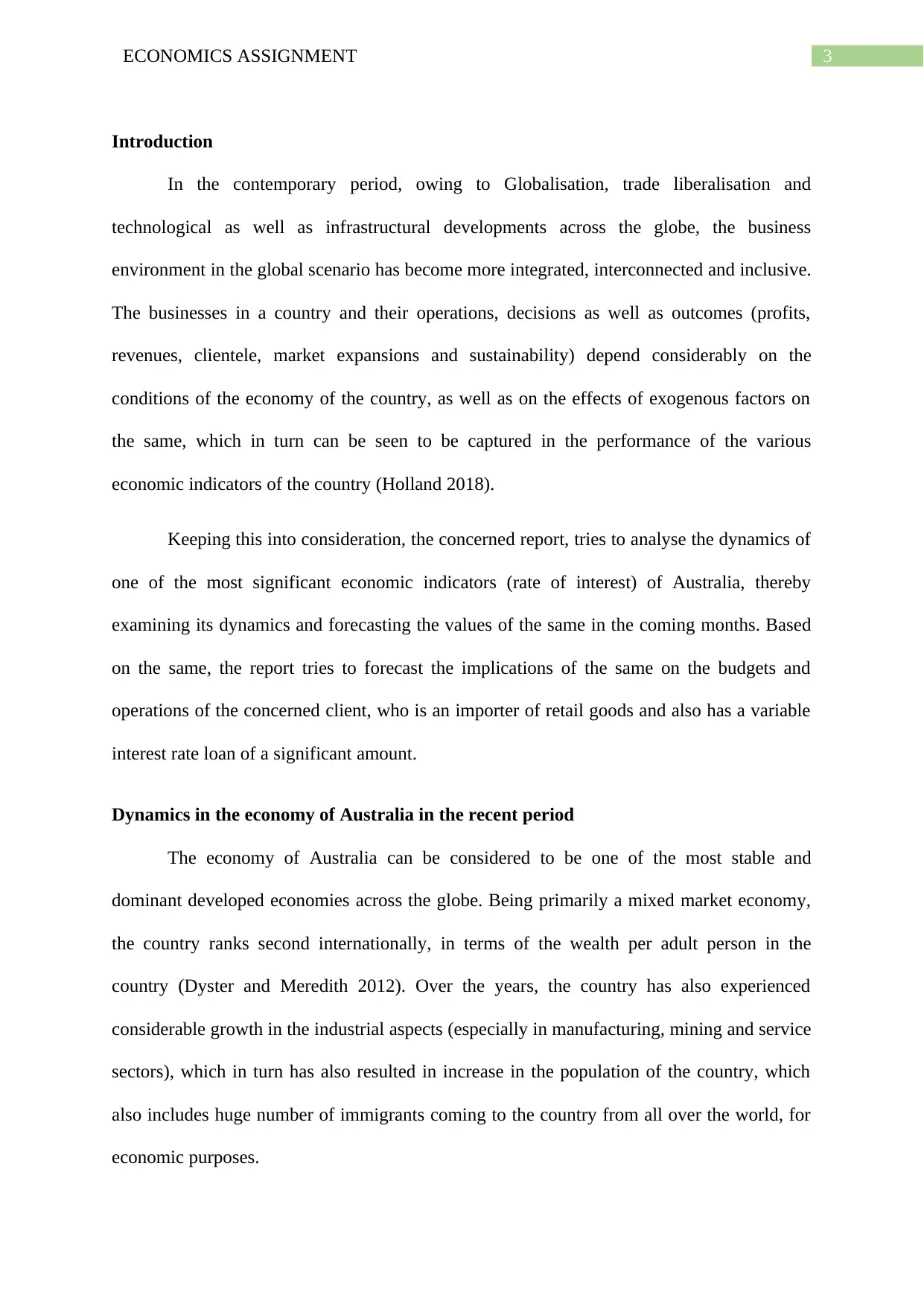
3ECONOMICS ASSIGNMENT
Introduction
In the contemporary period, owing to Globalisation, trade liberalisation and
technological as well as infrastructural developments across the globe, the business
environment in the global scenario has become more integrated, interconnected and inclusive.
The businesses in a country and their operations, decisions as well as outcomes (profits,
revenues, clientele, market expansions and sustainability) depend considerably on the
conditions of the economy of the country, as well as on the effects of exogenous factors on
the same, which in turn can be seen to be captured in the performance of the various
economic indicators of the country (Holland 2018).
Keeping this into consideration, the concerned report, tries to analyse the dynamics of
one of the most significant economic indicators (rate of interest) of Australia, thereby
examining its dynamics and forecasting the values of the same in the coming months. Based
on the same, the report tries to forecast the implications of the same on the budgets and
operations of the concerned client, who is an importer of retail goods and also has a variable
interest rate loan of a significant amount.
Dynamics in the economy of Australia in the recent period
The economy of Australia can be considered to be one of the most stable and
dominant developed economies across the globe. Being primarily a mixed market economy,
the country ranks second internationally, in terms of the wealth per adult person in the
country (Dyster and Meredith 2012). Over the years, the country has also experienced
considerable growth in the industrial aspects (especially in manufacturing, mining and service
sectors), which in turn has also resulted in increase in the population of the country, which
also includes huge number of immigrants coming to the country from all over the world, for
economic purposes.
Introduction
In the contemporary period, owing to Globalisation, trade liberalisation and
technological as well as infrastructural developments across the globe, the business
environment in the global scenario has become more integrated, interconnected and inclusive.
The businesses in a country and their operations, decisions as well as outcomes (profits,
revenues, clientele, market expansions and sustainability) depend considerably on the
conditions of the economy of the country, as well as on the effects of exogenous factors on
the same, which in turn can be seen to be captured in the performance of the various
economic indicators of the country (Holland 2018).
Keeping this into consideration, the concerned report, tries to analyse the dynamics of
one of the most significant economic indicators (rate of interest) of Australia, thereby
examining its dynamics and forecasting the values of the same in the coming months. Based
on the same, the report tries to forecast the implications of the same on the budgets and
operations of the concerned client, who is an importer of retail goods and also has a variable
interest rate loan of a significant amount.
Dynamics in the economy of Australia in the recent period
The economy of Australia can be considered to be one of the most stable and
dominant developed economies across the globe. Being primarily a mixed market economy,
the country ranks second internationally, in terms of the wealth per adult person in the
country (Dyster and Meredith 2012). Over the years, the country has also experienced
considerable growth in the industrial aspects (especially in manufacturing, mining and service
sectors), which in turn has also resulted in increase in the population of the country, which
also includes huge number of immigrants coming to the country from all over the world, for
economic purposes.
Paraphrase This Document
Need a fresh take? Get an instant paraphrase of this document with our AI Paraphraser
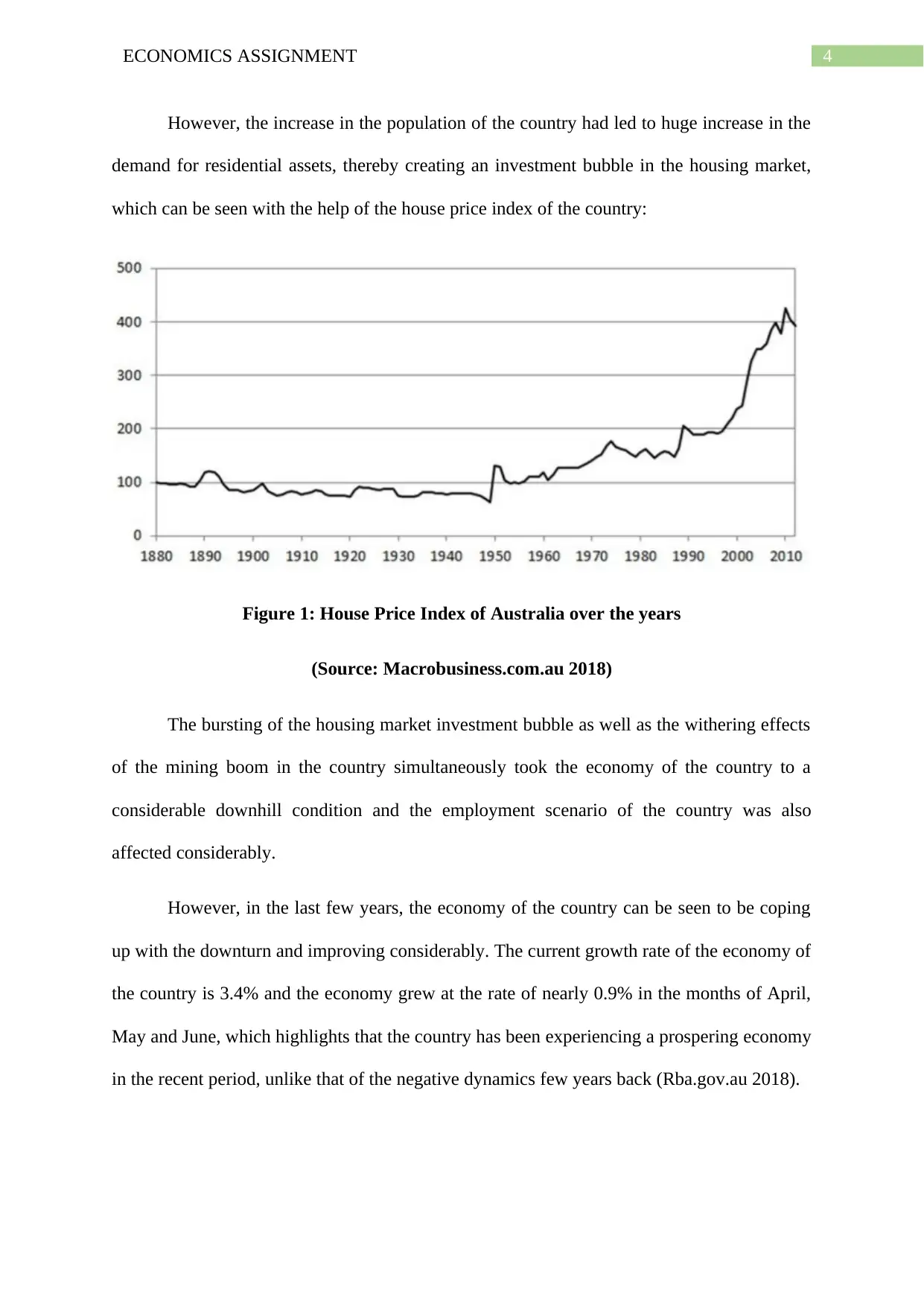
4ECONOMICS ASSIGNMENT
However, the increase in the population of the country had led to huge increase in the
demand for residential assets, thereby creating an investment bubble in the housing market,
which can be seen with the help of the house price index of the country:
Figure 1: House Price Index of Australia over the years
(Source: Macrobusiness.com.au 2018)
The bursting of the housing market investment bubble as well as the withering effects
of the mining boom in the country simultaneously took the economy of the country to a
considerable downhill condition and the employment scenario of the country was also
affected considerably.
However, in the last few years, the economy of the country can be seen to be coping
up with the downturn and improving considerably. The current growth rate of the economy of
the country is 3.4% and the economy grew at the rate of nearly 0.9% in the months of April,
May and June, which highlights that the country has been experiencing a prospering economy
in the recent period, unlike that of the negative dynamics few years back (Rba.gov.au 2018).
However, the increase in the population of the country had led to huge increase in the
demand for residential assets, thereby creating an investment bubble in the housing market,
which can be seen with the help of the house price index of the country:
Figure 1: House Price Index of Australia over the years
(Source: Macrobusiness.com.au 2018)
The bursting of the housing market investment bubble as well as the withering effects
of the mining boom in the country simultaneously took the economy of the country to a
considerable downhill condition and the employment scenario of the country was also
affected considerably.
However, in the last few years, the economy of the country can be seen to be coping
up with the downturn and improving considerably. The current growth rate of the economy of
the country is 3.4% and the economy grew at the rate of nearly 0.9% in the months of April,
May and June, which highlights that the country has been experiencing a prospering economy
in the recent period, unlike that of the negative dynamics few years back (Rba.gov.au 2018).
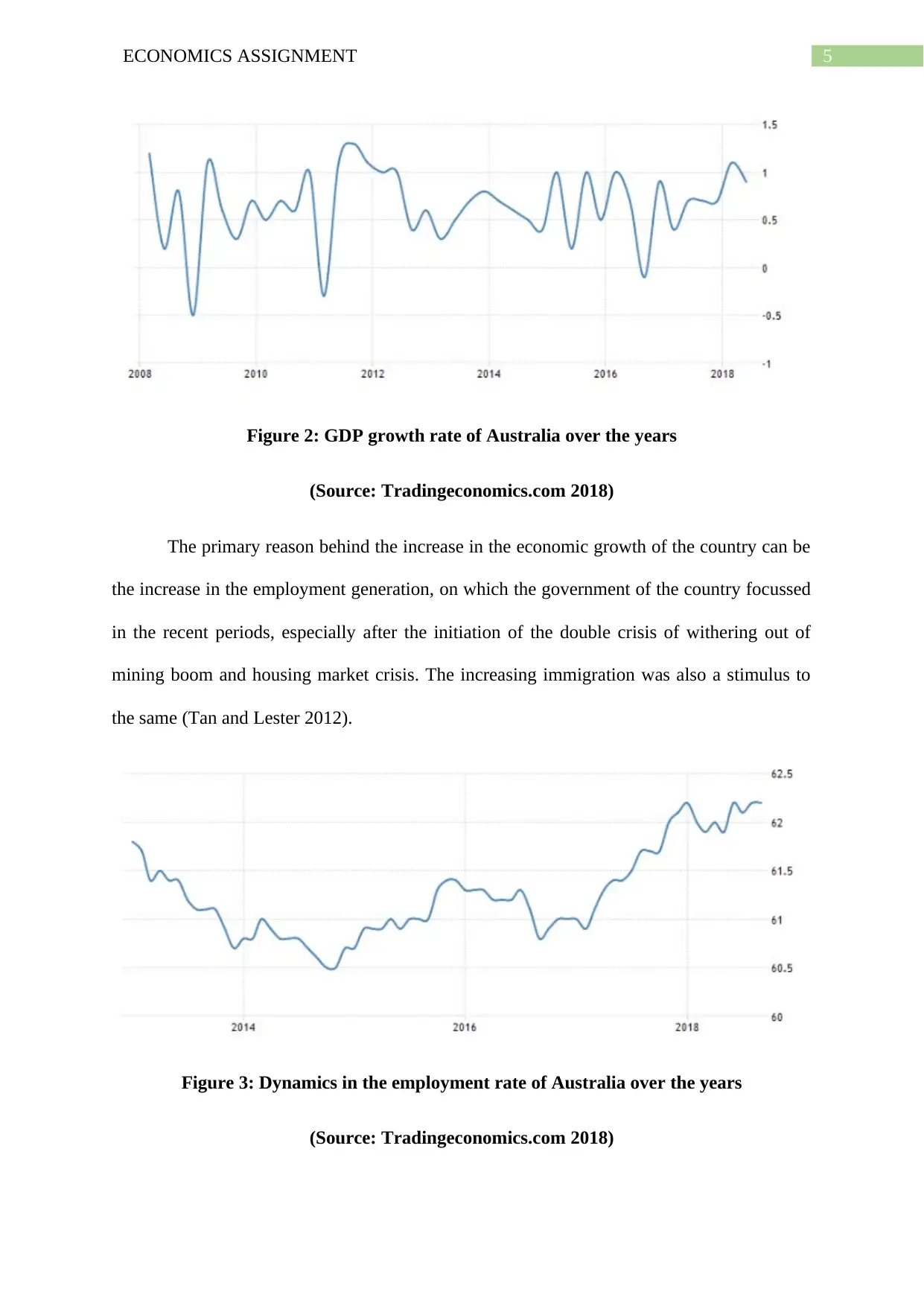
5ECONOMICS ASSIGNMENT
Figure 2: GDP growth rate of Australia over the years
(Source: Tradingeconomics.com 2018)
The primary reason behind the increase in the economic growth of the country can be
the increase in the employment generation, on which the government of the country focussed
in the recent periods, especially after the initiation of the double crisis of withering out of
mining boom and housing market crisis. The increasing immigration was also a stimulus to
the same (Tan and Lester 2012).
Figure 3: Dynamics in the employment rate of Australia over the years
(Source: Tradingeconomics.com 2018)
Figure 2: GDP growth rate of Australia over the years
(Source: Tradingeconomics.com 2018)
The primary reason behind the increase in the economic growth of the country can be
the increase in the employment generation, on which the government of the country focussed
in the recent periods, especially after the initiation of the double crisis of withering out of
mining boom and housing market crisis. The increasing immigration was also a stimulus to
the same (Tan and Lester 2012).
Figure 3: Dynamics in the employment rate of Australia over the years
(Source: Tradingeconomics.com 2018)
⊘ This is a preview!⊘
Do you want full access?
Subscribe today to unlock all pages.

Trusted by 1+ million students worldwide
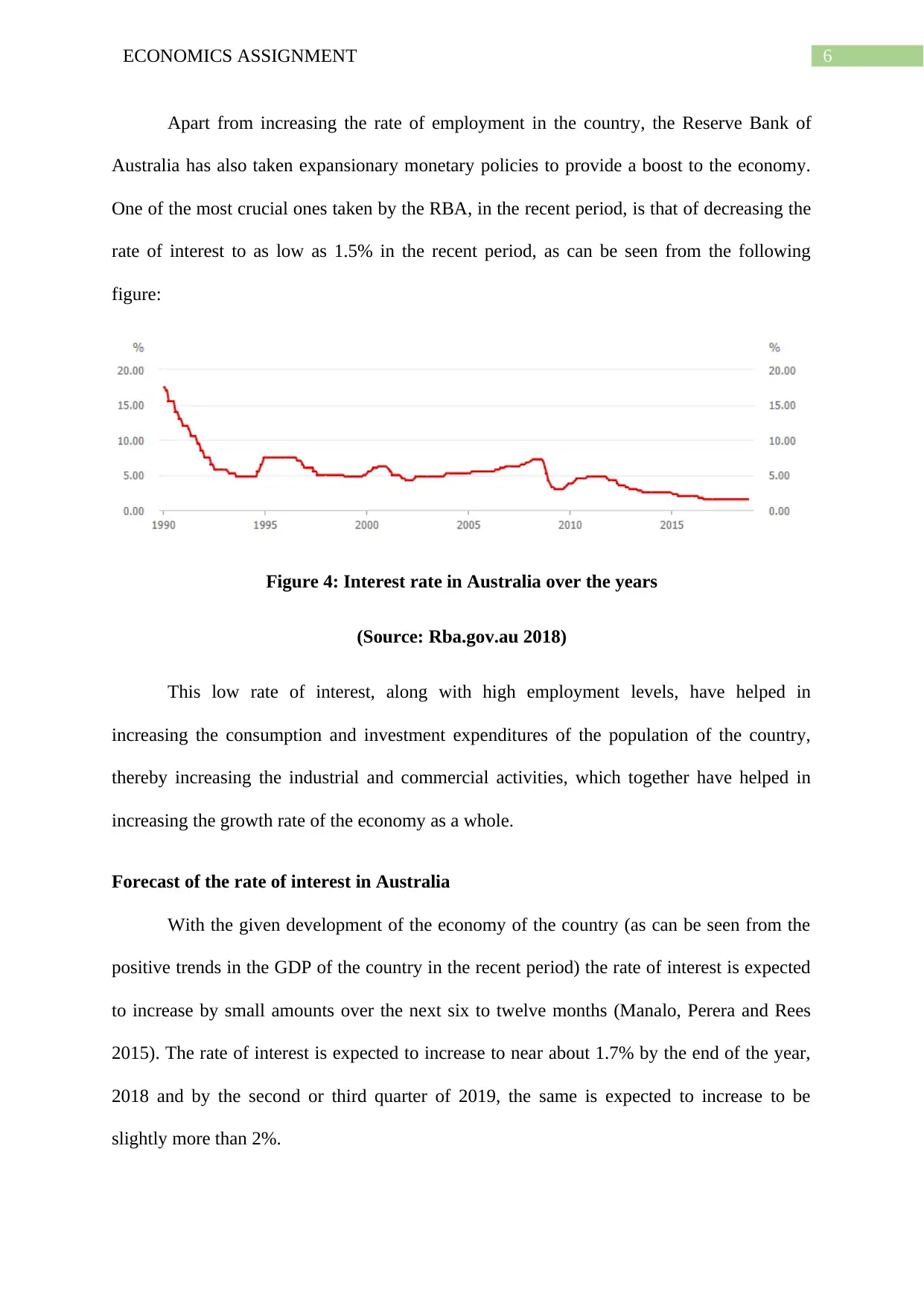
6ECONOMICS ASSIGNMENT
Apart from increasing the rate of employment in the country, the Reserve Bank of
Australia has also taken expansionary monetary policies to provide a boost to the economy.
One of the most crucial ones taken by the RBA, in the recent period, is that of decreasing the
rate of interest to as low as 1.5% in the recent period, as can be seen from the following
figure:
Figure 4: Interest rate in Australia over the years
(Source: Rba.gov.au 2018)
This low rate of interest, along with high employment levels, have helped in
increasing the consumption and investment expenditures of the population of the country,
thereby increasing the industrial and commercial activities, which together have helped in
increasing the growth rate of the economy as a whole.
Forecast of the rate of interest in Australia
With the given development of the economy of the country (as can be seen from the
positive trends in the GDP of the country in the recent period) the rate of interest is expected
to increase by small amounts over the next six to twelve months (Manalo, Perera and Rees
2015). The rate of interest is expected to increase to near about 1.7% by the end of the year,
2018 and by the second or third quarter of 2019, the same is expected to increase to be
slightly more than 2%.
Apart from increasing the rate of employment in the country, the Reserve Bank of
Australia has also taken expansionary monetary policies to provide a boost to the economy.
One of the most crucial ones taken by the RBA, in the recent period, is that of decreasing the
rate of interest to as low as 1.5% in the recent period, as can be seen from the following
figure:
Figure 4: Interest rate in Australia over the years
(Source: Rba.gov.au 2018)
This low rate of interest, along with high employment levels, have helped in
increasing the consumption and investment expenditures of the population of the country,
thereby increasing the industrial and commercial activities, which together have helped in
increasing the growth rate of the economy as a whole.
Forecast of the rate of interest in Australia
With the given development of the economy of the country (as can be seen from the
positive trends in the GDP of the country in the recent period) the rate of interest is expected
to increase by small amounts over the next six to twelve months (Manalo, Perera and Rees
2015). The rate of interest is expected to increase to near about 1.7% by the end of the year,
2018 and by the second or third quarter of 2019, the same is expected to increase to be
slightly more than 2%.
Paraphrase This Document
Need a fresh take? Get an instant paraphrase of this document with our AI Paraphraser
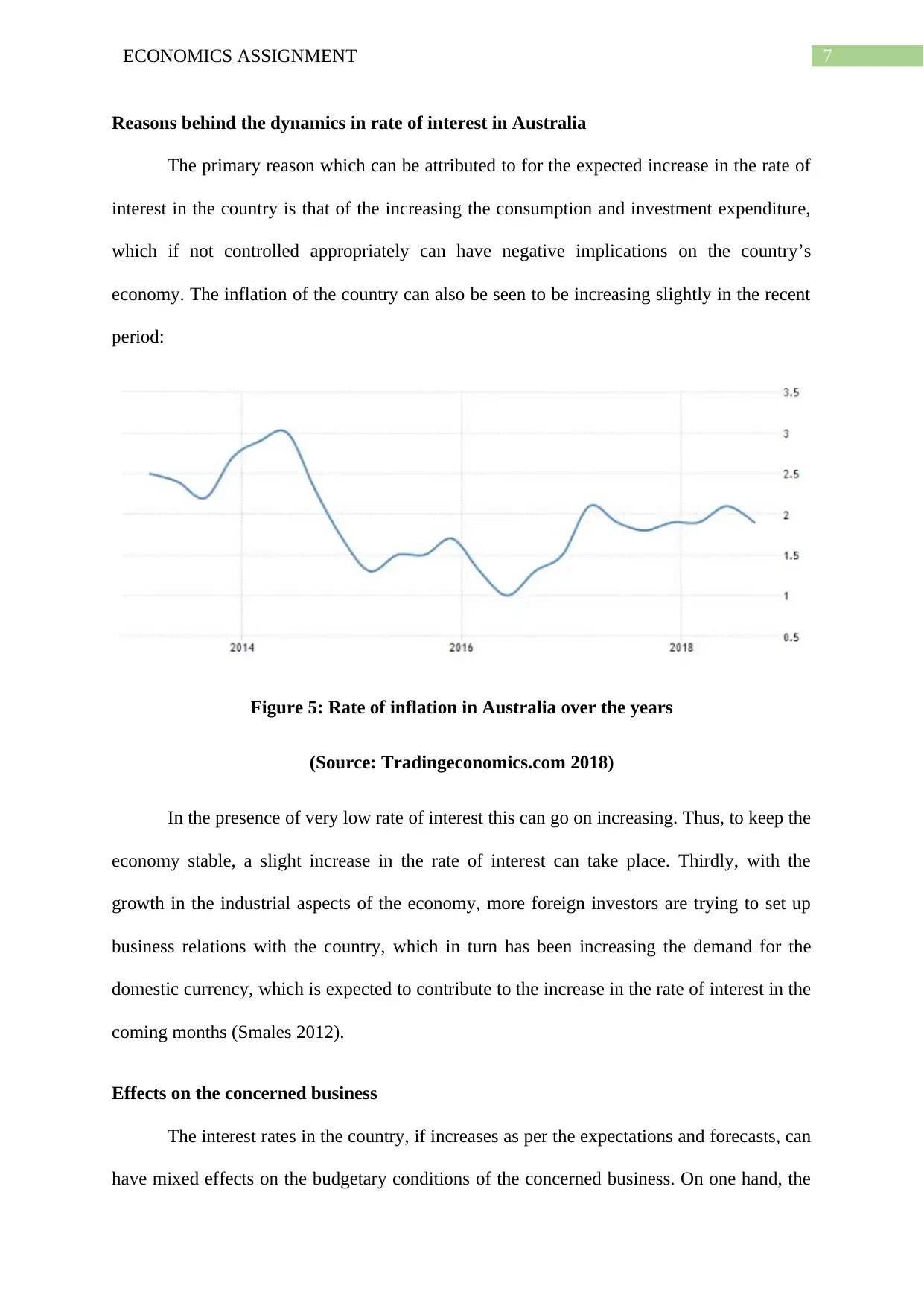
7ECONOMICS ASSIGNMENT
Reasons behind the dynamics in rate of interest in Australia
The primary reason which can be attributed to for the expected increase in the rate of
interest in the country is that of the increasing the consumption and investment expenditure,
which if not controlled appropriately can have negative implications on the country’s
economy. The inflation of the country can also be seen to be increasing slightly in the recent
period:
Figure 5: Rate of inflation in Australia over the years
(Source: Tradingeconomics.com 2018)
In the presence of very low rate of interest this can go on increasing. Thus, to keep the
economy stable, a slight increase in the rate of interest can take place. Thirdly, with the
growth in the industrial aspects of the economy, more foreign investors are trying to set up
business relations with the country, which in turn has been increasing the demand for the
domestic currency, which is expected to contribute to the increase in the rate of interest in the
coming months (Smales 2012).
Effects on the concerned business
The interest rates in the country, if increases as per the expectations and forecasts, can
have mixed effects on the budgetary conditions of the concerned business. On one hand, the
Reasons behind the dynamics in rate of interest in Australia
The primary reason which can be attributed to for the expected increase in the rate of
interest in the country is that of the increasing the consumption and investment expenditure,
which if not controlled appropriately can have negative implications on the country’s
economy. The inflation of the country can also be seen to be increasing slightly in the recent
period:
Figure 5: Rate of inflation in Australia over the years
(Source: Tradingeconomics.com 2018)
In the presence of very low rate of interest this can go on increasing. Thus, to keep the
economy stable, a slight increase in the rate of interest can take place. Thirdly, with the
growth in the industrial aspects of the economy, more foreign investors are trying to set up
business relations with the country, which in turn has been increasing the demand for the
domestic currency, which is expected to contribute to the increase in the rate of interest in the
coming months (Smales 2012).
Effects on the concerned business
The interest rates in the country, if increases as per the expectations and forecasts, can
have mixed effects on the budgetary conditions of the concerned business. On one hand, the
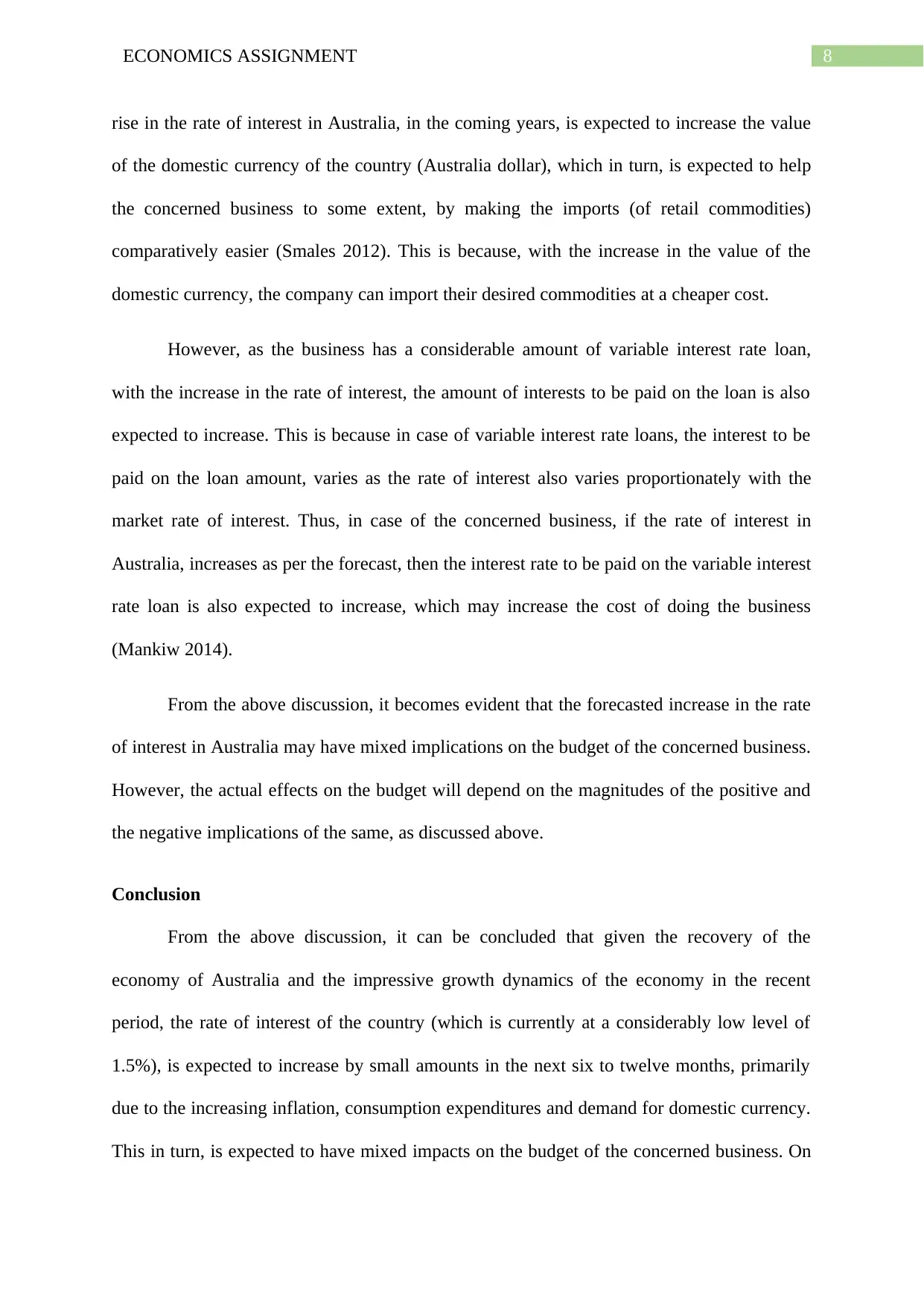
8ECONOMICS ASSIGNMENT
rise in the rate of interest in Australia, in the coming years, is expected to increase the value
of the domestic currency of the country (Australia dollar), which in turn, is expected to help
the concerned business to some extent, by making the imports (of retail commodities)
comparatively easier (Smales 2012). This is because, with the increase in the value of the
domestic currency, the company can import their desired commodities at a cheaper cost.
However, as the business has a considerable amount of variable interest rate loan,
with the increase in the rate of interest, the amount of interests to be paid on the loan is also
expected to increase. This is because in case of variable interest rate loans, the interest to be
paid on the loan amount, varies as the rate of interest also varies proportionately with the
market rate of interest. Thus, in case of the concerned business, if the rate of interest in
Australia, increases as per the forecast, then the interest rate to be paid on the variable interest
rate loan is also expected to increase, which may increase the cost of doing the business
(Mankiw 2014).
From the above discussion, it becomes evident that the forecasted increase in the rate
of interest in Australia may have mixed implications on the budget of the concerned business.
However, the actual effects on the budget will depend on the magnitudes of the positive and
the negative implications of the same, as discussed above.
Conclusion
From the above discussion, it can be concluded that given the recovery of the
economy of Australia and the impressive growth dynamics of the economy in the recent
period, the rate of interest of the country (which is currently at a considerably low level of
1.5%), is expected to increase by small amounts in the next six to twelve months, primarily
due to the increasing inflation, consumption expenditures and demand for domestic currency.
This in turn, is expected to have mixed impacts on the budget of the concerned business. On
rise in the rate of interest in Australia, in the coming years, is expected to increase the value
of the domestic currency of the country (Australia dollar), which in turn, is expected to help
the concerned business to some extent, by making the imports (of retail commodities)
comparatively easier (Smales 2012). This is because, with the increase in the value of the
domestic currency, the company can import their desired commodities at a cheaper cost.
However, as the business has a considerable amount of variable interest rate loan,
with the increase in the rate of interest, the amount of interests to be paid on the loan is also
expected to increase. This is because in case of variable interest rate loans, the interest to be
paid on the loan amount, varies as the rate of interest also varies proportionately with the
market rate of interest. Thus, in case of the concerned business, if the rate of interest in
Australia, increases as per the forecast, then the interest rate to be paid on the variable interest
rate loan is also expected to increase, which may increase the cost of doing the business
(Mankiw 2014).
From the above discussion, it becomes evident that the forecasted increase in the rate
of interest in Australia may have mixed implications on the budget of the concerned business.
However, the actual effects on the budget will depend on the magnitudes of the positive and
the negative implications of the same, as discussed above.
Conclusion
From the above discussion, it can be concluded that given the recovery of the
economy of Australia and the impressive growth dynamics of the economy in the recent
period, the rate of interest of the country (which is currently at a considerably low level of
1.5%), is expected to increase by small amounts in the next six to twelve months, primarily
due to the increasing inflation, consumption expenditures and demand for domestic currency.
This in turn, is expected to have mixed impacts on the budget of the concerned business. On
⊘ This is a preview!⊘
Do you want full access?
Subscribe today to unlock all pages.

Trusted by 1+ million students worldwide
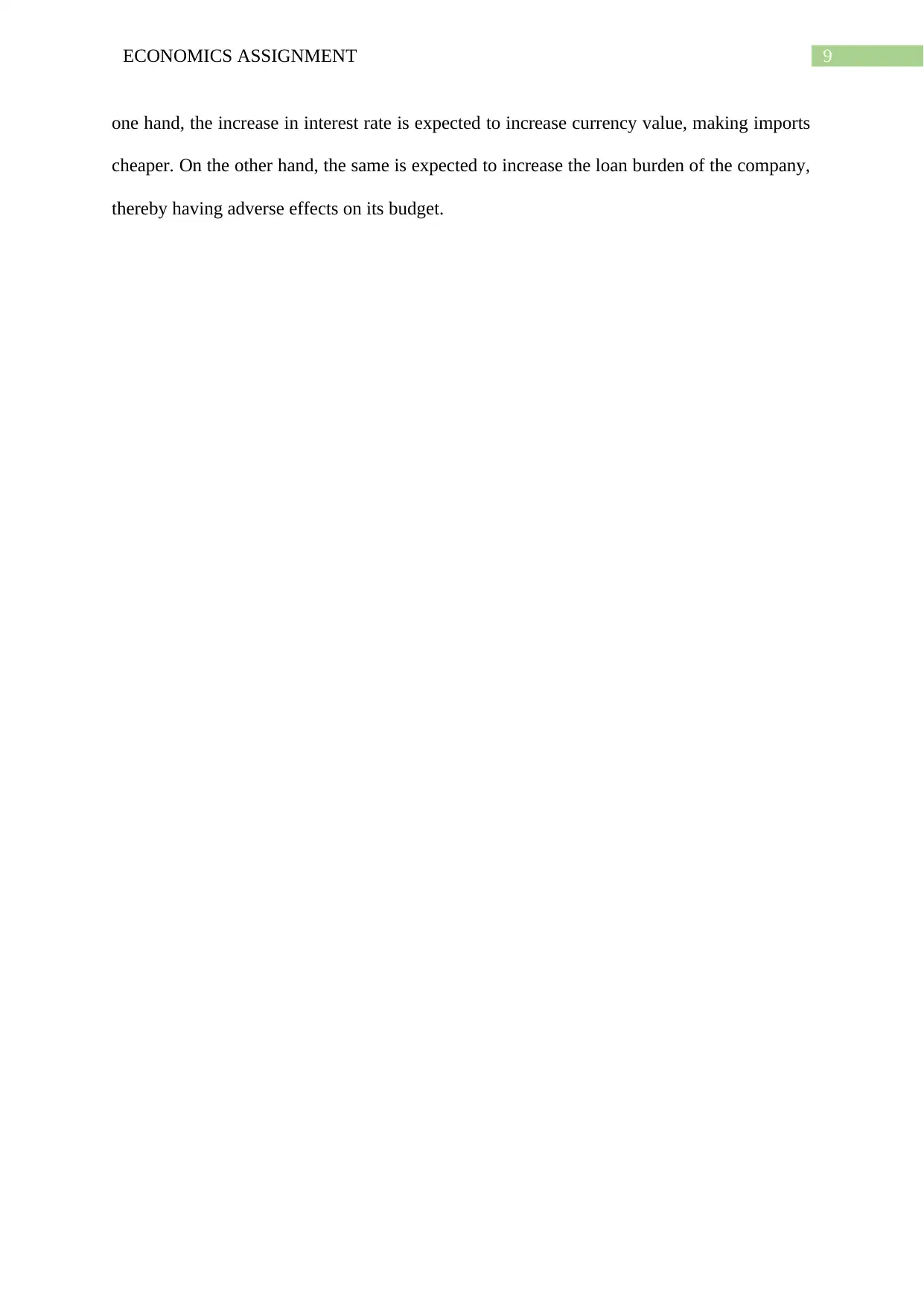
9ECONOMICS ASSIGNMENT
one hand, the increase in interest rate is expected to increase currency value, making imports
cheaper. On the other hand, the same is expected to increase the loan burden of the company,
thereby having adverse effects on its budget.
one hand, the increase in interest rate is expected to increase currency value, making imports
cheaper. On the other hand, the same is expected to increase the loan burden of the company,
thereby having adverse effects on its budget.
Paraphrase This Document
Need a fresh take? Get an instant paraphrase of this document with our AI Paraphraser
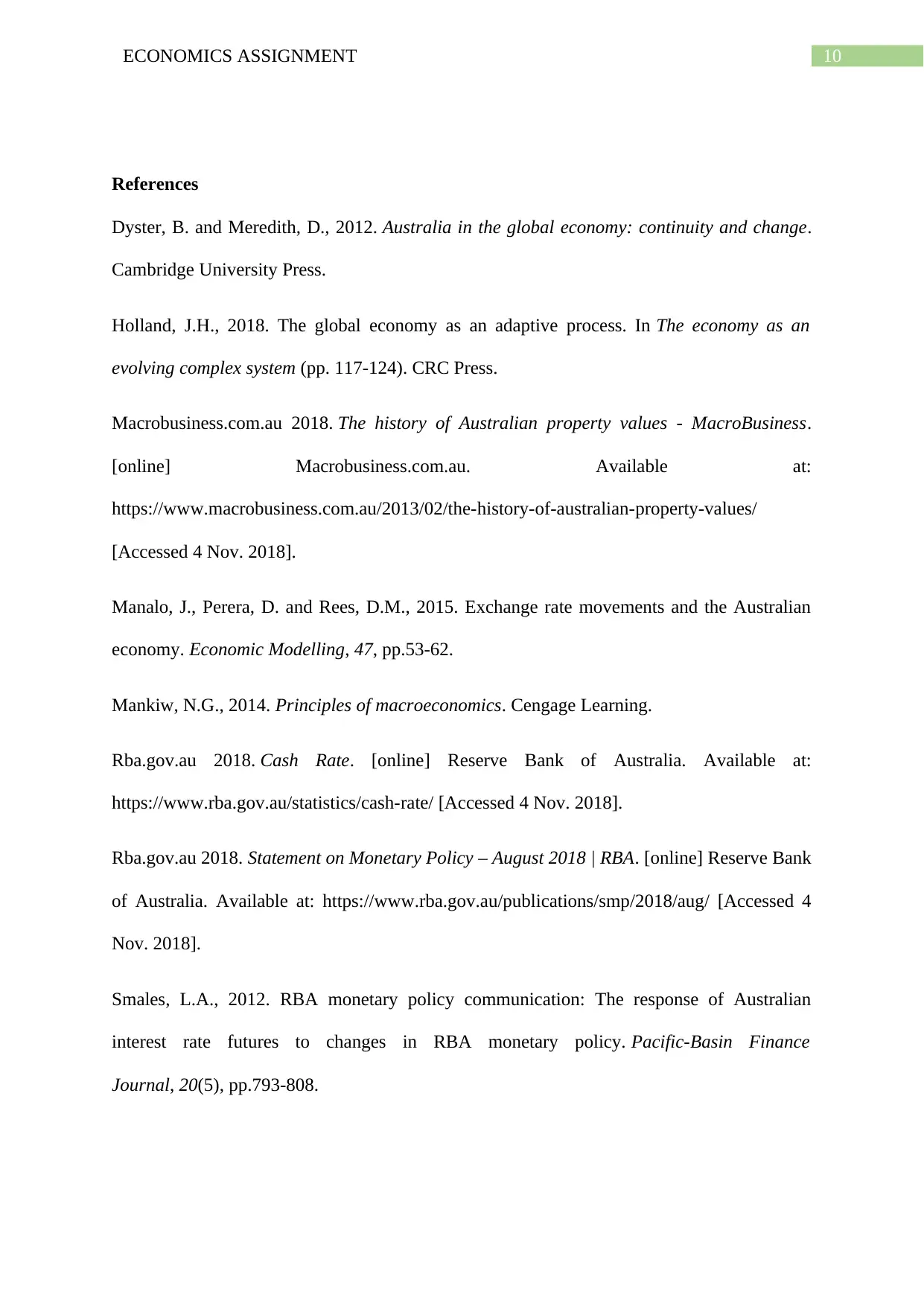
10ECONOMICS ASSIGNMENT
References
Dyster, B. and Meredith, D., 2012. Australia in the global economy: continuity and change.
Cambridge University Press.
Holland, J.H., 2018. The global economy as an adaptive process. In The economy as an
evolving complex system (pp. 117-124). CRC Press.
Macrobusiness.com.au 2018. The history of Australian property values - MacroBusiness.
[online] Macrobusiness.com.au. Available at:
https://www.macrobusiness.com.au/2013/02/the-history-of-australian-property-values/
[Accessed 4 Nov. 2018].
Manalo, J., Perera, D. and Rees, D.M., 2015. Exchange rate movements and the Australian
economy. Economic Modelling, 47, pp.53-62.
Mankiw, N.G., 2014. Principles of macroeconomics. Cengage Learning.
Rba.gov.au 2018. Cash Rate. [online] Reserve Bank of Australia. Available at:
https://www.rba.gov.au/statistics/cash-rate/ [Accessed 4 Nov. 2018].
Rba.gov.au 2018. Statement on Monetary Policy – August 2018 | RBA. [online] Reserve Bank
of Australia. Available at: https://www.rba.gov.au/publications/smp/2018/aug/ [Accessed 4
Nov. 2018].
Smales, L.A., 2012. RBA monetary policy communication: The response of Australian
interest rate futures to changes in RBA monetary policy. Pacific-Basin Finance
Journal, 20(5), pp.793-808.
References
Dyster, B. and Meredith, D., 2012. Australia in the global economy: continuity and change.
Cambridge University Press.
Holland, J.H., 2018. The global economy as an adaptive process. In The economy as an
evolving complex system (pp. 117-124). CRC Press.
Macrobusiness.com.au 2018. The history of Australian property values - MacroBusiness.
[online] Macrobusiness.com.au. Available at:
https://www.macrobusiness.com.au/2013/02/the-history-of-australian-property-values/
[Accessed 4 Nov. 2018].
Manalo, J., Perera, D. and Rees, D.M., 2015. Exchange rate movements and the Australian
economy. Economic Modelling, 47, pp.53-62.
Mankiw, N.G., 2014. Principles of macroeconomics. Cengage Learning.
Rba.gov.au 2018. Cash Rate. [online] Reserve Bank of Australia. Available at:
https://www.rba.gov.au/statistics/cash-rate/ [Accessed 4 Nov. 2018].
Rba.gov.au 2018. Statement on Monetary Policy – August 2018 | RBA. [online] Reserve Bank
of Australia. Available at: https://www.rba.gov.au/publications/smp/2018/aug/ [Accessed 4
Nov. 2018].
Smales, L.A., 2012. RBA monetary policy communication: The response of Australian
interest rate futures to changes in RBA monetary policy. Pacific-Basin Finance
Journal, 20(5), pp.793-808.
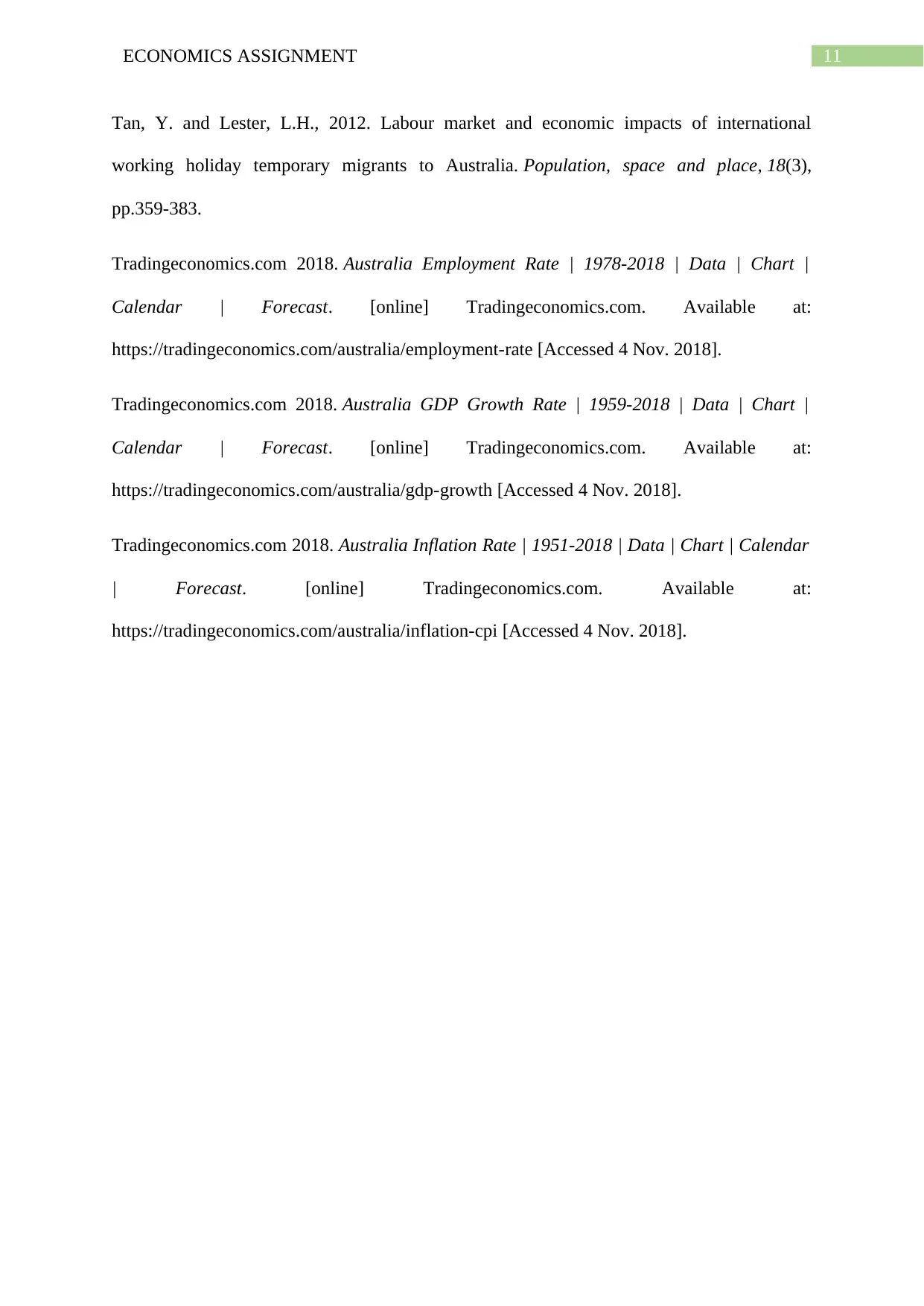
11ECONOMICS ASSIGNMENT
Tan, Y. and Lester, L.H., 2012. Labour market and economic impacts of international
working holiday temporary migrants to Australia. Population, space and place, 18(3),
pp.359-383.
Tradingeconomics.com 2018. Australia Employment Rate | 1978-2018 | Data | Chart |
Calendar | Forecast. [online] Tradingeconomics.com. Available at:
https://tradingeconomics.com/australia/employment-rate [Accessed 4 Nov. 2018].
Tradingeconomics.com 2018. Australia GDP Growth Rate | 1959-2018 | Data | Chart |
Calendar | Forecast. [online] Tradingeconomics.com. Available at:
https://tradingeconomics.com/australia/gdp-growth [Accessed 4 Nov. 2018].
Tradingeconomics.com 2018. Australia Inflation Rate | 1951-2018 | Data | Chart | Calendar
| Forecast. [online] Tradingeconomics.com. Available at:
https://tradingeconomics.com/australia/inflation-cpi [Accessed 4 Nov. 2018].
Tan, Y. and Lester, L.H., 2012. Labour market and economic impacts of international
working holiday temporary migrants to Australia. Population, space and place, 18(3),
pp.359-383.
Tradingeconomics.com 2018. Australia Employment Rate | 1978-2018 | Data | Chart |
Calendar | Forecast. [online] Tradingeconomics.com. Available at:
https://tradingeconomics.com/australia/employment-rate [Accessed 4 Nov. 2018].
Tradingeconomics.com 2018. Australia GDP Growth Rate | 1959-2018 | Data | Chart |
Calendar | Forecast. [online] Tradingeconomics.com. Available at:
https://tradingeconomics.com/australia/gdp-growth [Accessed 4 Nov. 2018].
Tradingeconomics.com 2018. Australia Inflation Rate | 1951-2018 | Data | Chart | Calendar
| Forecast. [online] Tradingeconomics.com. Available at:
https://tradingeconomics.com/australia/inflation-cpi [Accessed 4 Nov. 2018].
⊘ This is a preview!⊘
Do you want full access?
Subscribe today to unlock all pages.

Trusted by 1+ million students worldwide
1 out of 12
Related Documents
Your All-in-One AI-Powered Toolkit for Academic Success.
+13062052269
info@desklib.com
Available 24*7 on WhatsApp / Email
![[object Object]](/_next/static/media/star-bottom.7253800d.svg)
Unlock your academic potential
Copyright © 2020–2025 A2Z Services. All Rights Reserved. Developed and managed by ZUCOL.





